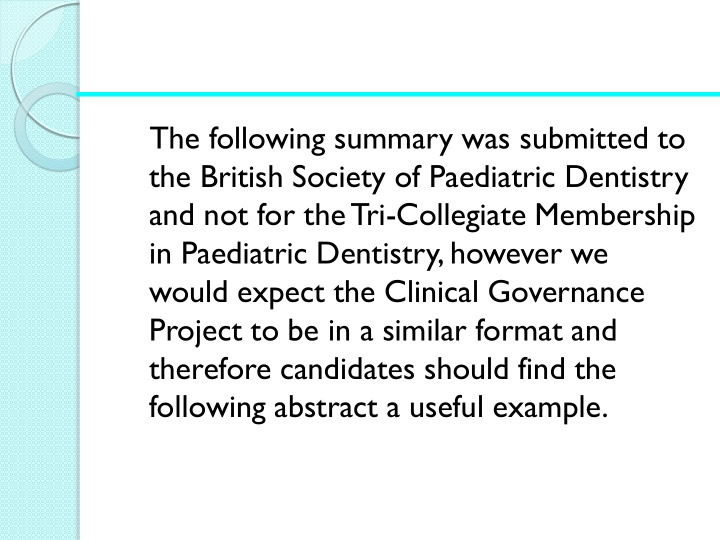



The following summary was submitted to the British Society of Paediatric Dentistry and not for the Tri-Collegiate Membership in Paediatric Dentistry, however we would expect the Clinical Governance Project to be in a similar format and therefore candidates should find the following abstract a useful example.
Antibiotic prescribing; a multi-centre audit Candidate Number 4
Antibiotics in dentistry Important role in paediatric dentistry Key issues: ◦ Antibacterial resistance ◦ Appropriate use ◦ Accurate prescriptions
Guidelines American Academy of Paediatric Dentistry Appropriate Acute facial swelling of dental origin Dental trauma Oral wounds contaminated with extrinsic bacteria Paediatric periodontal disease Inappropriate x Pulpitis x Apical periodontitis x Draining sinus tract x Localised intra-oral swelling in absence of systemic signs of infection
Guidelines Prescription accuracy Date Dose Patient’s name Frequency Address Duration Date of birth Quantity Age (if under 12) Prescriber’s signature Drug name Contact details Sugar-free elixirs Delivering Better Oral Health: An evidence-based toolkit for prevention Children at high caries risk should receive sugar-free medicines where possible
Aim To compare the prescribing practices in the paediatric departments of City1, City 2 and City3 dental hospitals
Objectives To examine if antibiotic therapy is used appropriately To assess prescription accuracy To determine if sugar-free elixirs are prescribed
Standards 100% of prescriptions should be in accordance with American Academy of Paediatric Dentistry guidelines 100% of prescriptions should be completed accurately in accordance with British National Formulary guidelines 100% of prescriptions for oral suspensions should stipulate ‘sugar - free’
Method Registered with Clinical Effectiveness Unit Retrospective case-note evaluation Pilot study in February 09 Data collection sheet ◦ Reason for prescription ◦ Antibiotic regime ◦ Correct details on prescription 90 patients, 30 consecutive patients per centre Data analysed using Microsoft Excel 2007
Results Cycle 1 data collected March - October 2009 Total of 89 patients Key results: 75% of patients were prescribed Amoxicillin 33% of antibiotics were appropriately prescribed 51% of prescriptions were accurately completed 53% of prescriptions requested sugar free
Action plan Results were disseminated at local clinical governance and regional audit meetings Inclusion of AAPD, FGDP(UK) clinical guidelines and BNF recommendations in departmental induction material Aide memoire produced and attached to prescription pad in City 1 hospital Re-audit
Appropriate use Cycle 1 (N=89) Cycle 2 (N=90) Diffuse facial swelling N=15 (17%) N=25 (28%) Pyrexia and local swelling N=6 (7%) N=5 (6%) Open wound management N=5 (5%) N=15 (17%) Following surgical intervention N=4 (4%) N=4 (4%) Total N=30 (33%) N=47 (52%)
Appropriate use by centre 70 Cycle 1 60 60 57 Cycle 2 50 50 47 Percentage (%) 40 30 27 20 17 10 0 City 1 City 2 City 3
Inappropriate use 30 26 Cycle 1 25 Cycle 2 20 Percentage (%) 15 13 13 11 10 8 8 8 7 6 5 4 0 Local swelling Local swelling Failed Pulpitis Pain + + pain treatment treatment delay
Prescription accuracy 46% (N=41) in cycle 2 compared with 51% in cycle 1 50 47 Cycle 1 Prescription errors 45 Cycle 2 40 35 33 33 Percentage (%) Types of error 30 26 25 20 % 15 10 6 4 4 5 2 2 2 1 0 Prescriber Date Patient Duration Quantity Sugar free details age
Results summary Prescription appropriateness from 33%-52% Prescription accuracy from 51%-46% Prescription of sugar free medicines from 53%-67%
Discussion Chate et al., 2006 Found with education and training: Appropriate prescribing increased from 29% to 49% Prescribing accuracy increased from 57% to 78% Room for further improvement Most common inappropriate reason for prescribing antibiotics was local swelling without systemic involvement Errors in prescription writing occur frequently
Conclusions Audit highlighted prescribing deficiencies in the 3 departments Audit findings comparable with previous studies Overall improvement in number of appropriate prescriptions and sugar free prescriptions Prescription accuracy continues to be a problem Planned 3 rd Audit cycle
References Standing Medical Advisory Committee. Sub-group on antimicrobial resistance. 1. The path of least resistance (synopsis) pp1-66. London: Dept. of Health 1998. Faculty of General Dental Practitioners (UK) Good Practice Guidelines. Adult 2. antimicrobial prescribing. London, 2000. Dailey YM, Martin MV. Are antibiotics being used appropriately for emergency 3. treatment Br Dent J 2001; 191: 391-393. Fedorowicz Z, Keenan JV, Farman AG, Newton T. Antibiotic use for irreversible 4. pulpitis. Cochrane Database of Systematic Reviews 2005, Issue 2. Chate RAC, White S, Hale L, et al. The impact of clinical audit on antibiotic 5. prescribing in general practice. Br Dent J 2006; 201: 635-641. American Academy of Paediatric Dentistry. Guidelines on the appropriate use of 6. antibiotic therapy for Paediatric Dental Patients. 2009 v31/6 09/10. http://www.aapd.org/media/policies.asp British Medical association. British National Formulary. Accessed on 5 th July 7. 2011. http://www.bnf.org/bnf/current/29420.htm Dept. of Health/British Association for the Study of Community Dentistry. 8. Delivering Better Oral Health. An evidence-based toolkit for prevention. 2 nd edition. London: Dept. of Health 2009.
Thank you
Recommend
More recommend